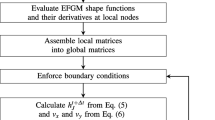Abstract
The element-free Galerkin (EFG) method is one of meshless methods, which is a very powerful, efficient and accurate method of modeling problems of fluid or solid mechanics with complex boundary shapes and large changes in boundary conditions. This paper reports the theory and the first-known application of the EFG method to groundwater flow modeling. The EFG method constructs shape functions based on moving least square (MLS) approximations, which do not require any element but only a set of nodes. Thus, the EFG method eliminates time-consuming mesh generation procedure with irregular shaped boundaries. The coupled EFG-FEM technique was used to treat Dirichlet boundary conditions. A computer code EFGGW was developed for the problems of steady-state and transient groundwater flow in homogeneous or heterogeneous aquifers. Solutions by the EFG method were similar in accuracy to that by the FEM. The main advantages of the method are the convenience of node generation and the enforced implementation of boundary conditions.
Similar content being viewed by others
References
Bear, J., 1972, Dynamics of Fluids in Porous Media. Denver, New York.
Belytschko, T. and Fleming, M., 1999, Smoothing, enrichment and contact in the element-free Galerkin method. Computers and Structures, 71, 173–195.
Belytschko, T., Krongauz, Y., Organ, D., Fleming, M. and Krysl, P., 1996, Meshless methods: an overview and recent developments. Computer Methods in Applied Mechanics and Engineering, 139, Mar-47.
Belytschko, T., Krysl, P. and Krongauz, Y., 1997, A three-dimensional explicit element-free Galerkin method. International Journal of Numerical Methods in Fluids, 24, 1253–1270.
Belytschko, T., Lu, Y.Y. and Gu, L., 1994, Element-free Galerkin methods. International Journal for Numerical Methods in Engineering, 37, 229–256.
Belytschko, T., Lu, Y.Y. and Gu, L., 1995, Crack propagation by element-free Galerkin methods. Engineering Fracture Mechanics, 51, 295–315.
Belytschko, T., Organ, D. and Krongauz, Y., 1995, A coupled finite element-free Galerkin method. Computational Mechanics, 17, 186–195.
Duarte, C.A. and Oden, T.J., 1996, H-p cloudsan h-p meshless method. Numerical Methods for Partial Differential Equations, 1–34.
Ferris, J.G., Knowles, D.B., Brown, R.H. and Stallman, R.W., 1962, theory of aquifer tests, U.S. Geological Survery Water-Supply Paper 1536-E, p. 69–174.
France, P.W., 1974, Finite element analysis of three-dimensional groundwater flow problems. Journal of Hydrology, 21, 381–398.
Freeze, R.A. and Cherry, J.A., 1979. Groundwater. Prentice-Hall, Englewood Cliffs, NJ.
Gray, S.K. and Pinder, G.F., 1976, Three-dimensional, transient, saturated-unsaturated flow in a groundwater basin. Water Resources Research, 7, 347–366.
Gupta, S.K., Cole, C.R. and Pinder, G.F., 1984, A finite-element three-dimensional groundwater (FE3DGW) model for a multiaquifer system. Water Resources Research, 20, 553–563.
Hoffman, J.D., 1992, Numerical Methods for Engineers and Scientists. McGraw-Hill, NY.
Hughes, T.J.R., 1987, The Finite Element Method. Englewood, Cliffs, Prentice-Hall, NJ.
Huyakorn, P.S. and Pinder, G.F., 1983, Computational Methods in Subsurface Flow. Academic Press, Inc., San Diego, 473 p.
Istok, J.D., 1989, Groundwater Modeling by the Finite Element Method. American Geophysical Union, DC.
Lancaster, P. and Salkauskas, K., 1981, Surface generated by moving least squares methods. Mathematics of computation, 37, 141–158.
Liu, W.K., Jun, S. and Zhang, Y.F., 1995, Reproducing Kernel particle methods. International Journal for Numerical Methods in Engineering, 20, 1081–1106.
Lu, Y.Y., Belytschko, T. and Gu, L., 1994, A new implementation of the element-free Galerkin method. Computer methods in Applied Mechanics and Engineering, 113, 397–414.
Lucy, L.B., 1977, A numerical approach to the testing of the fission hypothesis. The Astronomical Journal, 82, 1013–1024.
Nayroles, B., Touzot, G. and Villon, P., 1992, Generalizing the finite element method: diffuse approximation and diffuse elements. Computational Mechanics, 10, 307–318.
Onate, E., Idelsohn, S., Zienkiewicz, O.C., Taylor, R.L. and Sacco C., 1996, A stabilized finite point method for analysis of fluid mechanics problems. Computer Methods in Applied Mechanics and Engineering, 139, 315–46.
Organ, D.J., 1996, Numerical Solutions to Dynamic Fracture Problems Using the Element-Free Galerkin Method. Ph.D. thesis, Northwestern University.
Wang, H.F. and Anderson, M.P., 1982, Introduction to Groundwater Modeling, Finite Difference and Finite Element Methods. W.H. Freeman and Company, NY.
Witherspoon, P.A., Long, J.C.S., Major, E.L. and Myer, L.R., 1987, A new seismic-hydraulic approach to modeling flow in fractured rocks, In: Solving Ground-Water Problems with Models. National Water Well Association, Dublin, Ohio, p. 793–826.
Author information
Authors and Affiliations
Corresponding author
Rights and permissions
About this article
Cite this article
Park, YC., Leap, D.I. Modeling groundwater flow by the element-free Galerkin (EFG) method. Geosci J 4, 231–241 (2000). https://doi.org/10.1007/BF02910141
Received:
Accepted:
Issue Date:
DOI: https://doi.org/10.1007/BF02910141




